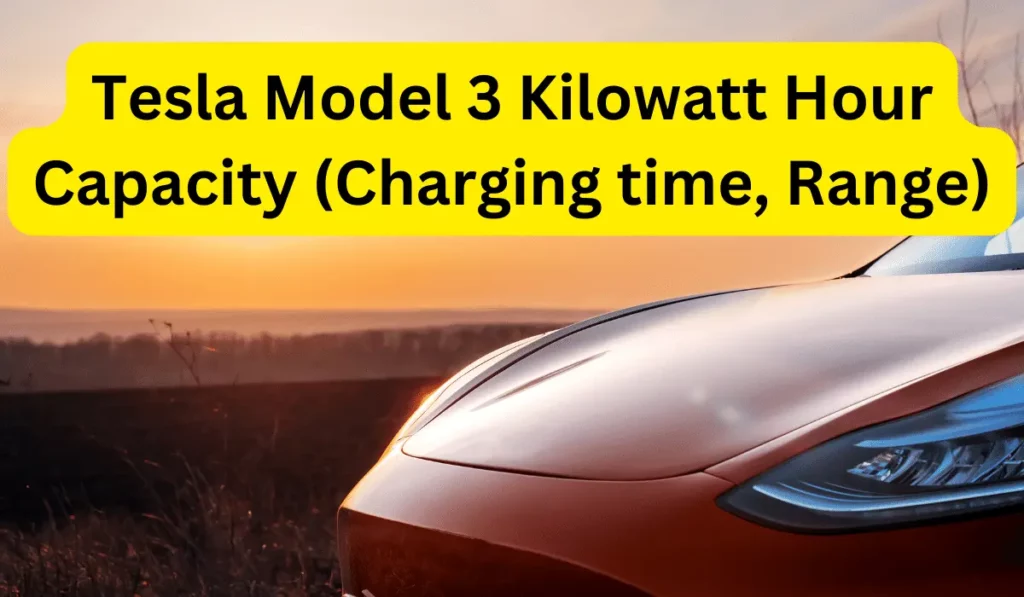The Tesla Model 3 is not just any electric car; it’s a marvel of engineering, boasting a sleek design, impressive performance, and cutting-edge battery technology. Let’s discuss the Model 3’s battery, its capacity, charging options, and what sets it apart from the competition.

Battery Capacity:
The Tesla Model 3 lineup offers different variants, each equipped with a unique battery capacity. While the regular Model 3 Rear-Wheel Drive comes with a 57.5 kWh battery, the Long Range and Performance versions feature larger batteries capable of holding up to 75 kWh. This diversity allows for varying ranges and performance capabilities across the Model 3 lineup.
Charging Options and Times:
Charging the Tesla Model 3 is convenient, thanks to its compatibility with various charging stations. At a standard charging spot, all Model 3 cars can charge up to 11 kW. Charging times vary; the Rear-Wheel Drive model takes approximately 6 hours and 15 minutes for a full charge, while the Long Range and Performance models require around 8 hours and 15 minutes.
For faster charging, DC fast charging stations are ideal. The Rear-Wheel Drive model can charge at up to 170 kW, while the Long Range and Performance models boast even faster charging speeds of up to 250 kW and 210 kW, respectively. This means you can charge from 10% to 80% in just 25 to 30 minutes, depending on the model.
Also Read:- Tesla Model Y Juniper Release Date USA & Features details
The Evolution of Battery Technology:
Tesla has been a pioneer in battery innovation, constantly pushing the boundaries of what’s possible. The latest Model 3s feature LFP (lithium-iron-phosphate) prismatic batteries supplied by CATL, offering improved performance and cost-effectiveness. These batteries contribute to the Model 3’s impressive range and longevity, with the potential to last hundreds of thousands of miles.
Understanding Battery Degradation:
Battery degradation is a concern for electric vehicle owners, but Tesla’s Model 3 has proven to be resilient over time. Elon Musk has stated that the Model 3’s battery pack is designed to last up to 1,500 charging cycles, equivalent to approximately 300,000 to 500,000 miles depending on the model. By following Tesla’s recommended charging guidelines, owners can maximize the lifespan of their battery and minimize degradation.
Looking to the Future:
As battery technology advances, the future looks bright for the Tesla Model 3. With improvements in battery chemistry and manufacturing processes, we can expect even greater range and efficiency in future iterations of the Model 3. Additionally, Tesla’s commitment to innovation means that enhancements in charging infrastructure and energy management systems will further enhance the ownership experience.
In conclusion
the Tesla Model 3 battery is a marvel of engineering, offering impressive performance, range, and longevity. Whether you’re a current owner or considering purchasing one, understanding how the battery works is essential for maximizing your driving experience.
I am the mind behind nammatech.com. I have an experience of more than 8 years in the digital marketing field. The idea behind starting this blog came when one of my friends find it difficult to fill out the application form. So, I came up with an idea to start a blog on this niche.

![Low-Income Housing for Seniors near me in USA [2024] Low-income-housing-for-seniors](https://nammatech.com/wp-content/uploads/2023/03/Low-income-housing-for-seniors-150x150.webp)
![Low-Income Housing for Disabled Adults, Seniors Near me [2024] housing for disabled adults](https://nammatech.com/wp-content/uploads/2023/03/Low-income-housing-for-disabled-with-no-waiting-list-near-me-USA1-150x150.webp)
![Low-income housing with no waiting list near me in [2024] Low-income housing with no waiting list near me](https://nammatech.com/wp-content/uploads/2023/03/Low-income-housing-with-no-waiting-list-near-me-150x150.webp)



